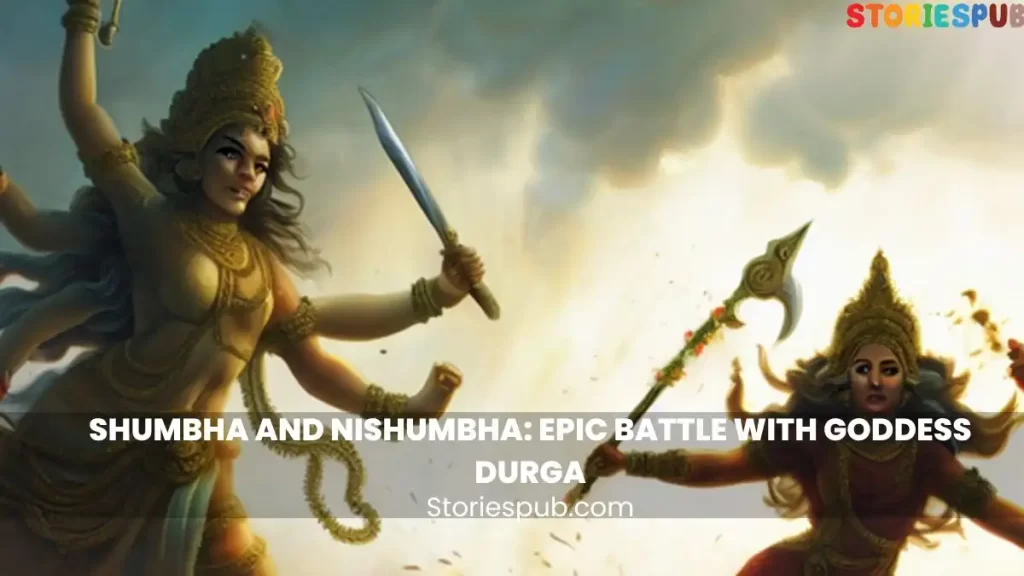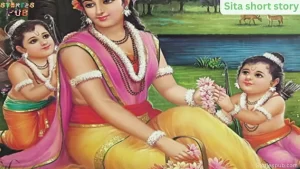Shumbha and Nishumbha: Epic Battle with Goddess Durga

Long ago, in ancient India, the world of gods and demons was in constant turmoil. Shumbha and Nishumbha, two formidable demons, were central figures in this cosmic struggle. Born from the demon king Diti and her husband Kashyapa, Shumbha and Nishumbha were brothers who would later become powerful demon kings.
Growing up in a world of strife and chaos, Shumbha and Nishumbha’s upbringing revolved around learning the arts of war and mastering dark magic. Their rigorous training and indomitable will propelled them to the forefront of the demon world, earning them the status of kings among their brethren. As they grew in power and influence, they sought to subdue the world of gods and establish themselves as the supreme rulers of the universe.
In response to the threat posed by the demon brothers, the gods prepared for battle, knowing that they would eventually have to face the formidable duo. As the tension between the gods and demons escalated, the balance of the universe hung in the balance.
The major event that led to the battle between Shumbha-Nishumbha and the gods was the capture of the heavens by the demons. Shumbha and Nishumbha, along with their vast army of demons, waged war against the gods, defeating them and forcing them to retreat. The demons, led by the victorious brothers, took control of the celestial realms, displacing the gods from their heavenly abode.
As the gods despaired over their defeat and sought a way to reclaim their territories, they decided to invoke the divine mother, Goddess Durga. It was said that only she could bring an end to the tyranny of the demon brothers. In a moment of great spiritual unity, the gods channeled their energies to create the all-powerful Durga, who embodied the essence of their collective strength.
The story of Shumbha and Nishumbha and their eventual confrontation with Goddess Durga is narrated in the ancient text known as the “Chandi Path” or “Devi Mahatmyam.” This sacred text, part of the Markandeya Purana, recounts the heroic exploits of the goddess as she vanquished various demons and brought peace to the universe.
As the gods watched from their celestial abode, Goddess Durga took the form of a warrior, riding a ferocious lion into battle. Armed with divine weapons bestowed upon her by the gods, Durga engaged Shumbha and Nishumbha’s demon army in a fierce and bloody battle. The goddess, undeterred by the sheer numbers of her enemies, unleashed her divine wrath upon the demon hordes, cutting through them with ease.
In the final confrontation, Shumbha and Nishumbha met Goddess Durga in single combat. Even with their incredible powers and mastery of dark magic, the brothers were no match for the divine fury of the goddess. In a climactic battle, Durga vanquished the demon brothers, restoring the balance of the universe and returning the heavens to the gods.
The story of Shumbha and Nishumbha serves as a reminder of the importance of humility and the dangers of unchecked ambition. The demon brothers’ quest for power and domination ultimately led to their downfall, teaching a valuable lesson about the virtue of restraint and the consequences of excessive pride.
Throughout history, the tale of Shumbha and Nishumbha has been depicted in various art forms and retellings. From intricate temple carvings to mesmerizing dance performances, the story has been kept alive by the diverse cultures of India. These artistic expressions reflect the enduring significance of this mythological narrative and the profound impact it has had on the collective consciousness of Hindu spirituality.
The mythological narrative of Shumbha and Nishumbha serves as a powerful allegory for the struggle between good and evil, order and chaos, that pervades the cosmos. It highlights the importance of divine intervention in maintaining the delicate balance of the universe and the necessity for virtuous qualities such as courage, humility, and selflessness to triumph over darker, destructive forces.
This epic tale also offers insights into the nature of Hindu cosmology and the complex relationships between gods, demons, and humans. It illustrates the cyclical nature of existence, where periods of strife and discord inevitably give way to harmony and balance, only to be disrupted once again by forces seeking to assert their dominance.
Furthermore, the story of Shumbha and Nishumbha underscores the central role of the divine feminine in Hindu mythology. Goddess Durga, as the embodiment of the collective strength and power of the gods, symbolizes the ultimate victory of righteousness over evil. Her fierce and indomitable spirit has served as a source of inspiration for countless devotees throughout history, encouraging them to confront adversity with unwavering faith and determination.
In conclusion, the story of Shumbha and Nishumbha, an epic Hindu mythological tale, weaves together an intricate tapestry of themes, characters, and lessons that continue to resonate with audiences today. Through the brothers’ rise to power, their eventual defeat at the hands of Goddess Durga, and the timeless moral values that emerge from their story, this ancient narrative offers a rich and nuanced exploration of the complexities of human nature and the eternal struggle between good and evil. Ultimately, it stands as a testament to the enduring power of mythology to illuminate the human experience and to inspire hope, courage, and wisdom in the face of life’s greatest challenges.
Shumbha and Nishumbha FAQ
How are Shumbha and Nishumbha related to Goddess Durga?
Shumbha and Nishumbha challenged Goddess Durga after they heard about her divine beauty. The ensuing battle between them and the goddess is an important part of Hindu mythology.
What is the origin story of Shumbha and Nishumbha?
Shumbha and Nishumbha were born from the sweat of Brahma's forehead. They were raised by Kamsa, the evil king of Mathura, who taught them the ways of the demons.
How did Shumbha and Nishumbha become powerful demon kings?
They performed severe penance to please Lord Brahma, who granted them immense powers and near invincibility, with the only exception being that they could be defeated by a woman.
What is the significance of the "Chandi Path" or "Devi Mahatmyam" in relation to the Shumbha-Nishumbha story?
The "Chandi Path" or "Devi Mahatmyam" is a sacred text that narrates the story of Goddess Durga, including her battle against Shumbha and Nishumbha. It highlights the goddess's power and victory over evil forces.
How were Shumbha and Nishumbha defeated by Goddess Durga?
Goddess Durga fought against Shumbha and Nishumbha, along with their army of demons, in a fierce battle. She defeated their forces and ultimately killed both demon brothers, restoring peace and order.
What are the lessons and moral values that can be derived from the story of Shumbha and Nishumbha?
The story teaches the importance of humility, as Shumbha and Nishumbha's arrogance led to their downfall. It also highlights the power of good over evil and the protective role of the divine feminine.
How have the characters of Shumbha and Nishumbha been depicted in various art forms and retellings?
Shumbha and Nishumbha are often portrayed as fearsome demon kings in traditional paintings and sculptures. They have also been depicted in various dance and theatrical performances, particularly those focused on the story of Goddess Durga.
How does the story of Shumbha and Nishumbha contribute to the broader understanding of Hindu mythology and spirituality?
The story showcases the power of the divine feminine in Hinduism, as Goddess Durga defeats the demon brothers. It also emphasizes the triumph of good over evil and the importance of humility and devotion in spiritual practice.
Are there any rituals or festivals associated with the story of Shumbha and Nishumbha?
The story of Shumbha and Nishumbha is often remembered and celebrated during the Navaratri festival, which honors Goddess Durga and her victory over evil forces. The recitation of the "Chandi Path" or "Devi Mahatmyam" is a significant part of the festival.
Hey kids, how much did you like The Shumbha and Nishumbha: Epic Battle with Goddess Durga? Please share your view in the comment box. Also, please share this story with your friends on social media so they can also enjoy it, and for more such Hindu Mythology, , please bookmark storiespub.com.
Check out other stories that we have:



